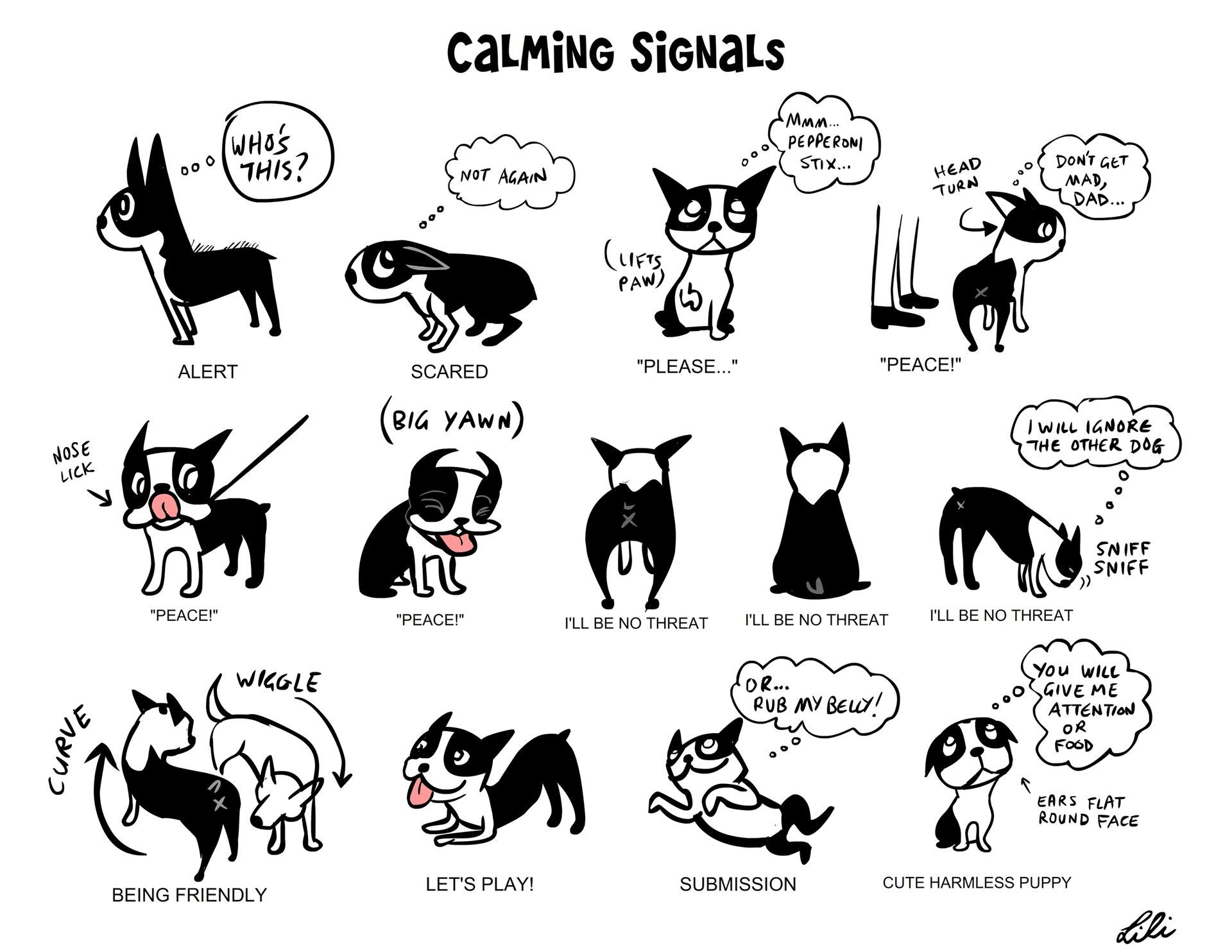Five Ways a Dog Behaviorist Deciphers Your Dog’s Body Language
Learning To Read Your Dog During Obedience Training
Learning to identify what your dog is saying by their body language will help you better interpret their needs and respond appropriately. Here are 5 ways a dog behaviorist interprets body signals of your dog during obedience training:
1.
Tail Wagging:
Most dog owners view tail wagging as an obvious sign of happiness. However, all a wagging tail means is that the dog is emotionally aroused. A dog can be excited or frustrated. A dog behaviorist quickly identifies your dog’s neutral trail position in order to recognize when the dog’s emotions have shifted. If the dog’s tail is pointing down or even tucked between their legs, it means the dog is fearful or stressed, whereas an assertive dog will keep their tail high. The direction and speed of the tail wag also indicates to the behaviorist if the dog is feeling positive or negative about something.
2. Facial Expressions: Dog’s have similar facial features as people, but they don’t use them in the same way. Yawning is a great example of contrasting facial expressions. When people yawn it usually means they are tired or bored. Dogs, however, yawn when they’re stressed. Dog’s use yawning to calm themselves in tense situations and to calm their owners. Dog’s also use lip-licking as a way to signal they are feeling anxious. Sometimes the tongue flick is too quick to notice, but the repetitive action will signify your dog’s discomfort with a given situation.
Speak With A Dog
Training Expert
Speak With A Dog Training Expert
Thank you for contacting us!
We will contact you shortly!
Please try again later.
3. Posture: A dog’s posture can tell a lot about their mood and intentions. A dog behaviorist will point out the dog’s weight distribution and relate it to the type of fear or stress, aggression, submissiveness, or playfulness it may be showing.
4. Eyes:
A dog’s eyes can be soft or hard. Soft eyes have relaxed lids and sometimes look like the dog is squinting. Soft eyes indicate the dog is calm or happy. Hard eyes, however, indicate a negative state of mind resulting in a hard stare, usually signifying a threat. Eye contact is also a way the dog expresses discomfort through hard stares or avoiding eye contact all together. “Whale” eyes are another indicator that a dog is feeling anxious or stressed. This means the dog is showing the whites of their eyes. A dog might do this when they feel uncomfortable or think someone is trying to steal something of theirs.
5. Raised Hackles: Just as humans get goosebumps, dogs have involuntary reactions when they are upset, stressed, excited or intensely interested in something. This reaction is called “piloerection” and refers to the hair that fluffs up across the shoulder or down the dog’s back all the way to the tail. A dog behaviorist will take into consideration facial expressions and other cues from a dog when presented with raised hackles to determine the source of emotion its body is responding to.
Obedience Training Meets Adaptation
All dogs have one thing in common: the societal pressure to be a “good dog.” Adopting and raising a handicapped dog is a wonderful humane act. However, whatever limitations your dog may face does not make them immune to societal expectations. Thankfully, obedience training is an enriching activity that can be achieved by any dog, regardless of their limitations, and is the first step toward helping your dog adjust to living in a high pressure world.
The first step for a dog obedience trainer is to identify your dog’s limitations. Understanding what caused your dog's disability will give the trainer insight into how your dog needs to be communicated with, helps the trainer set reasonable expectations, and also helps your dog’s trainer avoid any pain points on your furry family member. Similar to human beings, disabilities in dogs can
Speak With A Dog
Training Expert
Speak With A Dog Training Expert
Thank you for contacting us!
We will contact you shortly!
Please try again later.
arise due to various reasons. Some dogs are born with disabilities, while others may become handicapped due to congenital or contracted diseases or injury. It is quite common for a dog to experience blindness, deafness, or experience mobility challenges that can require training modifications. An expert dog obedience trainer will be able to create a training program for your dog that will help your dog to avoid painful movement and have fun while learning new skills. Your dog’s trainer will also be able to take advantage of your dog’s heightened senses to help make adaptive learning possible. Focusing on your dog’s available senses will help you as the owner understand your dog’s strengths and weaknesses and rethink the way your dog needs to be communicated with. With all of this in mind, the obedience trainer will be able to put together an adaptive learning plan to suit your dog and its unique needs.


Preparing Your Home For A Disabled Dog
First and foremost, it is important to remind any dog owner or future dog owner that owning any pet is a lifetime commitment. It is crucial that your dog is fully integrated into your everyday life and that it knows you are dedicated to ongoing care for it. Time is an aspect of dedication towards your dog. Adopting or owning a disabled dog requires time invested into researching and understanding your dog's limitations. Time is also required for dedicated training and working with your disabled dog. A lot of patience and attention to training is needed compared to a fully able dog, and alternative training techniques created by a professional trainer can be time consuming.
The financial responsibility of caring for a disabled dog is another factor to consider when making this life long commitment. While some disabilities do not require medical intervention, others may require ongoing treatment or medical expenses is the disability has the potential to worsen as the
Dog Training Is More Than Sit and Stay
For canines, the phrase “actions speak louder than words” rings true for their communication style. While dogs do make sounds of barking, whining and growling, more often they rely on nonverbal body language. The way a dog communicates is quite different from how humans communicate with one another. These differences often lead to many human-dog misunderstandings. Dog body language is simply unfamiliar... after all, humans don’t have tails! At times, a dog displays behaviors that might seem to directly mimic that of human behavior, such as a yawn, but the meaning is really in direct contrast to what that action would signify as a human.
A dog who is enrolled in obedience training will learn a variety of cues and verbal commands that indicate what is expected of them. But really, obedience training is for the owner to understand how their dog naturally communicates- whether that be through good behavior or bad behavior. A newfound understanding of a dog’s emotional state will help its owner predict the dog’s behavior and prevent problems before they occur. Dog body language signals all act as part of a package. When reading a dog’s communication, it must be looked at from every signal the dog is using: from the tail height to the eye shape. A dog is “talking” all the time, and learning what your dog is saying will help you develop a deeper bond of trust and respect.
dog ages. Tools are another financial investment needed to help a dog’s limitations adapt to its environment. For example, a head collar or halter may be needed to help a blind dog navigate new spaces by preventing it from bumping into barriers. If your dog has a mobility handicap, a dog cart or lifting harness can be used to help your dog move around without much pain. Private obedience training classes are also another crucial investment for helping you and your dog adapt to its lifestyle in its home and social environments. An obedience trainer will help you teach your handicapped dog how to associate obedience with good things through positive reinforcement. The trainer will also help you learn how to be observant to your dog's signals and cues for communicating its needs. The obedience trainer will also help to nurture a great relationship between you and your handicapped dog by prioritizing simple obedience instructions for you and your dog to learn together.
Dogs are remarkable creatures. Owning a dog with a handicap can help you learn new ways to look at and adapt to the world around you. While a dog’s disabilities can make obedience training more challenging, Enrolling your disabled dog into an obedience training program will expand their ability to live a full and rewarding life.
